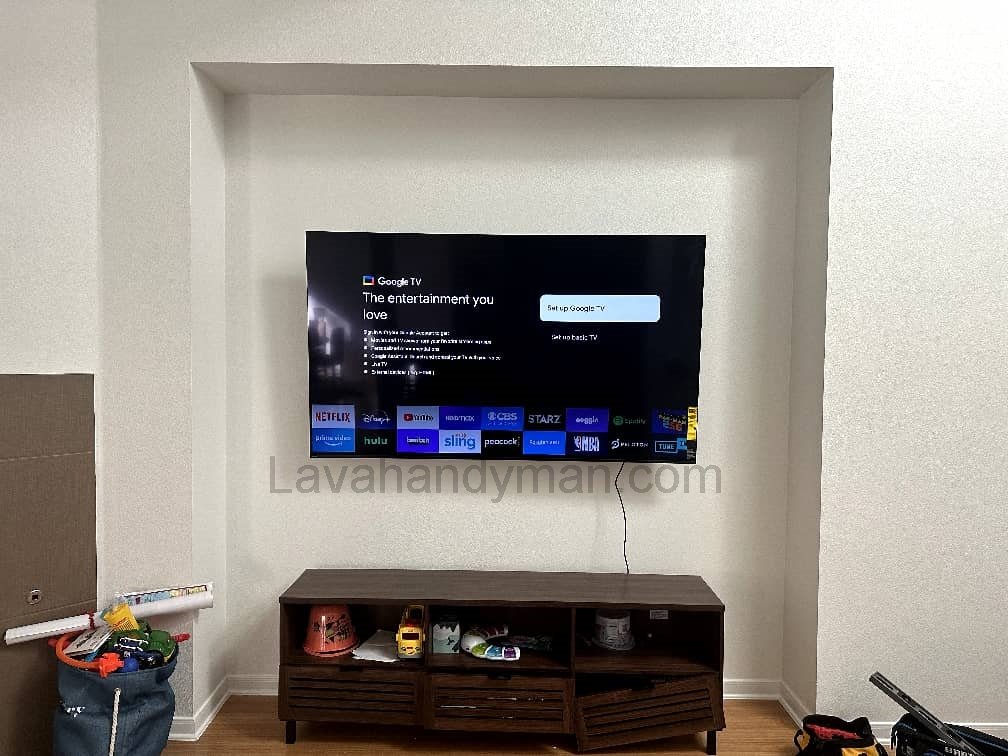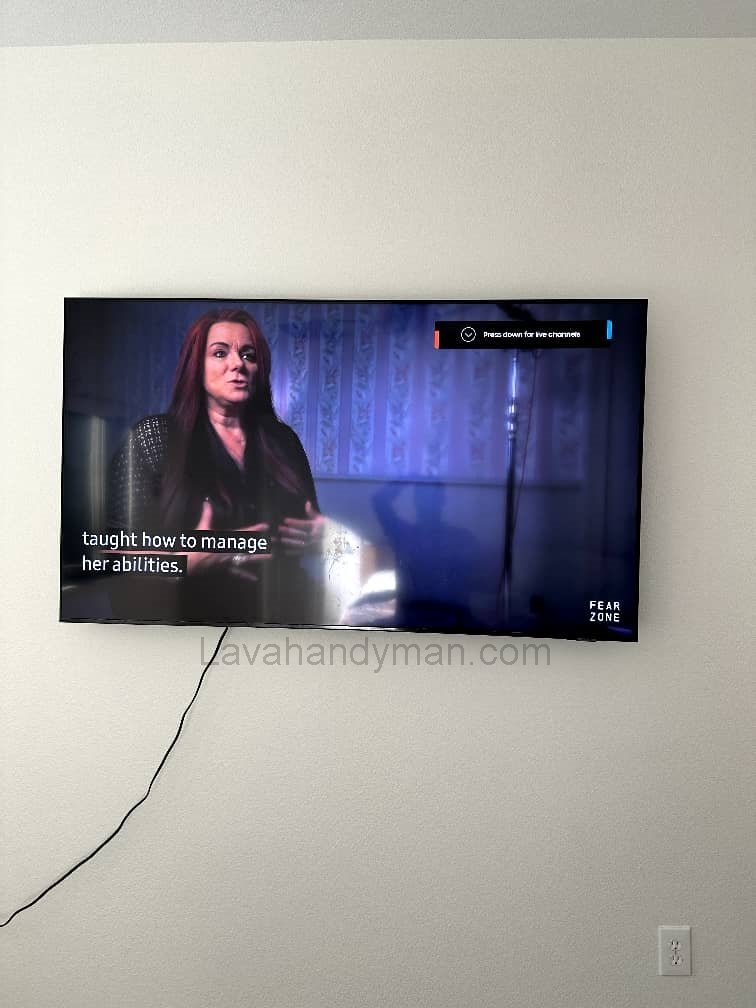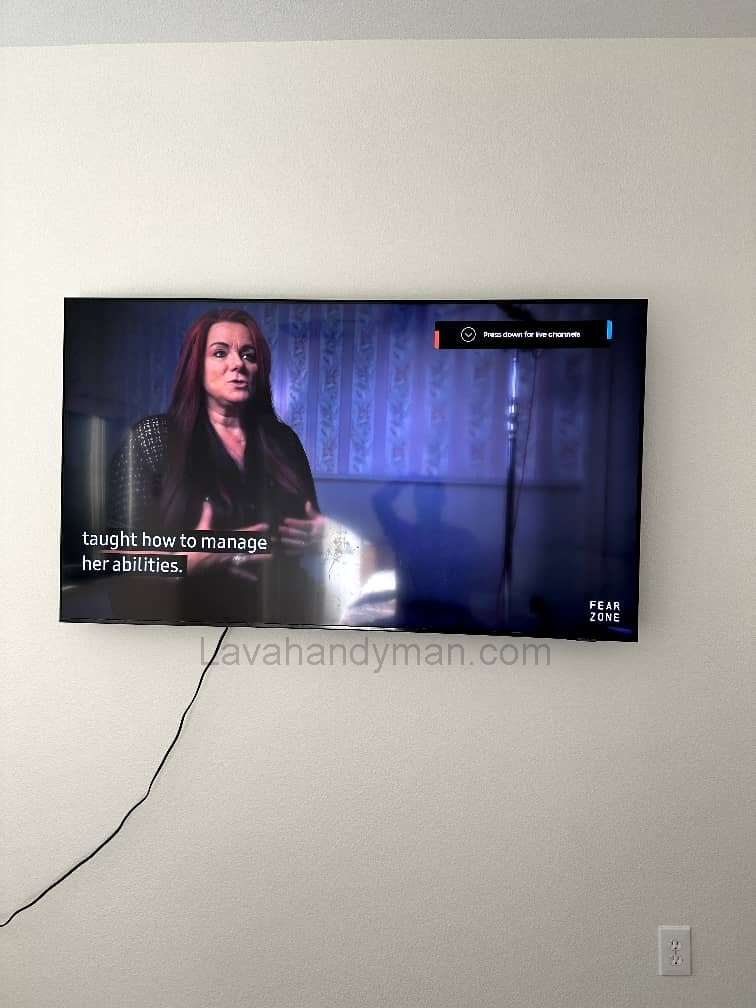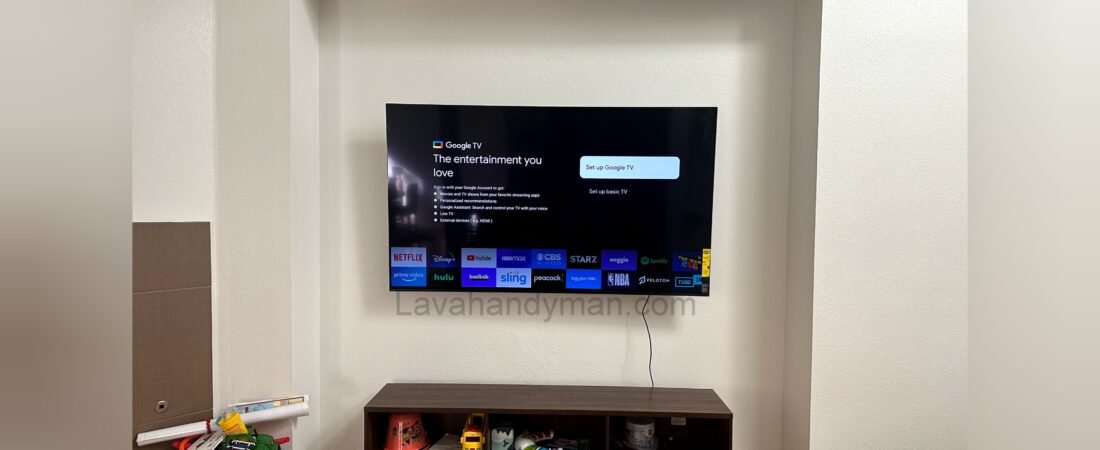Wall-Mounting a Large-Screen TV | Practical Guide
Introduction
With the rise of slim and flat-screen TVs, wall-mounting has become a popular choice for both homes and offices. Mounting your large TV on the wall not only saves space but also gives your room a sleek, modern look.
However, installing a large TV safely and correctly requires careful planning, the right tools, and attention to important safety tips. This comprehensive guide walks you through the step-by-step process of mounting a large-screen TV on the wall — from choosing the right wall to avoiding common mistakes.
Wall-Mounting a Large-Screen TV | Practical Guide
Part 1: Why Mount Your TV on the Wall?
1. Space-Saving
Wall-mounting eliminates the need for bulky TV stands, freeing up floor space.
2. Clean and Modern Aesthetic

A wall-mounted TV looks neater and more elegant, especially when the cables are hidden.
3. Increased Safety
Mounting the TV out of reach of children and pets reduces the risk of tipping or falling.
4. Better Viewing Experience
With proper height and angle, watching TV becomes more comfortable and enjoyable.
Wall-Mounting a Large-Screen TV | Practical Guide
Part 2: Pre-Installation Considerations
1. Choosing the Right Wall
- Concrete or brick walls are ideal for a secure installation.
- Drywall or plasterboard requires special anchors and hardware to support the TV’s weight.
2. Checking TV Size and Weight
- Match the TV’s weight with the bracket’s load capacity.
- TVs over 65 inches require heavy-duty wall mounts.
3. Determining the Correct Height
The TV center should be at eye level when seated — typically around 90 to 110 cm (35 to 43 inches) from the floor.
Wall-Mounting a Large-Screen TV | Practical Guide
Part 3: Tools and Equipment You’ll Need
| Tool | Purpose |
|---|---|
| Electric drill | Drilling holes into the wall |
| Level (manual or laser) | Ensuring the mount is straight |
| Tape measure | Accurate measurements |
| Pencil or marker | Marking hole positions |
| Screwdriver or socket wrench | Fastening screws |
| Wall mount bracket | Holds the TV securely |
| Anchors and screws | For attaching the bracket to the wall |
| Stud finder or wire detector | Avoiding hidden wires or pipes |
| Cable management kit | Hides and organizes wires neatly |
Wall-Mounting a Large-Screen TV | Practical Guide
Part 4: Step-by-Step Installation Guide
Step 1: Prepare the Area
- Choose a spot close to a power outlet and cable ports.
- Clear the area and place your TV face-down on a soft surface nearby.
- Plan your cable routes (power, HDMI, antenna, etc.).
Step 2: Mark the Mounting Points
- Hold the wall bracket against the wall.
- Mark the screw holes using a pencil.
- Use a level to make sure the bracket is perfectly straight.
Step 3: Drill the Holes
- Use the right drill bit size for your wall type.
- Drill holes at the marked points.
- For drywall, insert proper wall anchors.
- Always check for electrical wires before drilling.
Wall-Mounting a Large-Screen TV | Practical Guide
Step 4: Mount the Bracket
- Insert the wall anchors (if needed).
- Secure the bracket to the wall using strong screws.
- Check once more with a level to ensure it’s straight.
Step 5: Attach Bracket to the TV
- Locate the VESA holes on the back of the TV.
- Secure the second part of the bracket to the TV.
- Avoid over-tightening the screws.
Step 6: Hang the TV on the Wall
- With the help of another person, lift the TV and hook it onto the wall bracket.
- Ensure it’s securely locked in place.
- Adjust tilt or angle if the mount supports it.
Step 7: Manage the Cables
- Connect power, HDMI, and other cables.
- Use cable channels or organizers to hide and tidy up cables.
Wall-Mounting a Large-Screen TV | Practical Guide
Part 5: Safety Tips
- Never mount the TV alone. Always have someone assist you, especially with large screens.
- Use high-quality tools and brackets. Poor-quality materials can lead to accidents.
- Know your wall type. Mounting on unsuitable walls can be dangerous.
- Use the correct VESA-compatible mount. It must match your TV’s size and weight.
- Stay close to power outlets. Avoid long or loose cables.
- Use a surge protector. This protects your TV from power spikes.
Part 6: Common Installation Mistakes
- Mounting too high or too low
Causes neck strain and discomfort. - Skipping the level
Results in a crooked TV alignment. - Choosing the wrong bracket
May not support your TV properly. - Ignoring cable management
Leads to a cluttered, messy look. - Drilling into live wires
Always use a stud finder or wire detector.
Wall-Mounting a Large-Screen TV | Practical Guide

Part 7: Special Scenarios
In the Bedroom
TVs in bedrooms are often mounted slightly higher to accommodate reclining or lying-down viewing.
On Drywall
Use toggle bolts or specialized drywall anchors to prevent pulling out.
With Articulating (Swivel) Arms
These mounts allow angle adjustments but require stronger anchoring and wall support.
Wall-Mounting a Large-Screen TV | Practical Guide
Part 8: After Installation Checklist
- Clean up dust and debris from drilling.
- Double-check that cables are secure and tidy.
- Test all TV functions (remote, HDMI input, sound, etc.).
- Lightly push the TV to make sure it’s stable.
- Lock the mount if it has a safety mechanism.
✅ Types of Wall Mounts for Large TVs
A Complete Guide to Choosing the Right Bracket
If you’re planning to mount your large-screen TV on the wall, choosing the right wall bracket is one of the most important steps. Wall mounts come in various types, each with its own features, benefits, and limitations. Below is a breakdown of the most common and practical TV wall mounts, especially for large TVs:
Wall-Mounting a Large-Screen TV | Practical Guide
1. Fixed Wall Mount
🔹 The simplest and most affordable option
🔹 The TV sits flat against the wall, with minimal gap
🔹 Ideal for rooms where the viewing angle is always straight-on
✅ Pros:
- Easy installation
- Budget-friendly
- Strong and secure
- Clean and minimal look
🚫 Limitations:
- No tilt or angle adjustments
- Hard to access ports once mounted
Wall-Mounting a Large-Screen TV | Practical Guide
2. Tilting Wall Mount
🔹 Allows vertical tilt (up/down)
🔹 Great for TVs mounted higher on the wall (e.g., above a fireplace)
✅ Pros:
- Improves viewing angle
- Reduces screen glare from lights or windows
- Ideal for watching TV while lying down or sitting low
🚫 Limitations:
- Does not swivel left or right
Wall-Mounting a Large-Screen TV | Practical Guide
3. Full-Motion / Articulating Wall Mount
🔹 Most flexible and adjustable type
🔹 Comes with extendable arms that swivel, tilt, and pull out
🔹 Lets you move the TV in various directions
✅ Pros:
- Maximum flexibility in viewing angles
- Ideal for open-plan spaces or multiple seating areas
- Easy access to TV ports and back panel
- Great for kitchens, large living rooms, or bedrooms
🚫 Limitations:
- More expensive
- Complex installation
- Requires a strong wall (preferably concrete or stud-supported drywall)
Wall-Mounting a Large-Screen TV | Practical Guide
4. Ceiling Mount
🔹 Used when wall-mounting is not an option
🔹 Attaches to the ceiling, often with rotation or tilt features
✅ Pros:
- Saves wall space entirely
- Offers wide viewing angles
- Perfect for commercial settings, shops, or classrooms
🚫 Limitations:
- Requires professional installation
- Ceiling must be structurally strong
- Less common in home setups
Wall-Mounting a Large-Screen TV | Practical Guide
5. Motorized / Pull-Down Mount
🔹 High-end solution with motorized or manual vertical movement
🔹 Designed for TVs placed above fireplaces or in high positions
✅ Pros:
- Allows height adjustment
- Remote control available in motorized versions
- Premium look and convenience
🚫 Limitations:
- More expensive than other types
- May require power connection and extra wiring
- Professional installation often recommended
🔧 Important Technical Note: VESA Compatibility
VESA (Video Electronics Standards Association) is the universal standard for mounting holes on the back of a TV. Every TV has a VESA size (e.g., 200×200, 400×400), which must match the bracket you’re using.
For example:
- VESA 200×200 – suitable for small to medium TVs
- VESA 400×400 and above – recommended for large TVs (55″ and up)
📌 Three key factors when choosing a bracket:
- TV weight
- Screen size
- Wall type (concrete, drywall, plaster, etc.)
✅ Summary
For premium solutions, motorized or pull-down mounts add convenience and style.
If you want a simple, sturdy, and affordable option, go with a fixed mount.
If you want better vertical angles, choose a tilting mount.
For full flexibility and better access, a full-motion (articulating) mount is ideal.
For special locations or commercial use, ceiling mounts work best.
📺 Complete Guide to Choosing the Right TV Size
What Size Is Best for Your Space?
✅ What Does TV Size Mean?
TV size refers to the diagonal measurement of the screen, not the width or height of the body. It’s measured in inches, from one corner of the screen to the opposite corner.
For example, a 55-inch TV means the screen measures 55 inches diagonally.
📐 Common TV Sizes and Ideal Use
Size (Inches) Ideal Location Recommended Viewing Distance
32″ Bedroom, Kitchen 1.5 to 2 meters (5–6.5 ft)
43″ Small rooms, home office 2 to 2.5 meters (6.5–8 ft)
50–55″ Medium living room 2.5 to 3.5 meters (8–11.5 ft)
65″ Large living rooms 3 to 4 meters (10–13 ft)
75″ and above Home theaters, villas 4 meters and more (13+ ft)
📏 How to Choose the Right TV Size
- Based on Viewing Distance:
Use this simple formula:
java
Copy
Edit
Viewing distance (in meters) × 40 ≈ Ideal screen size (in inches)
Example: If your sofa is 2.5 meters away from the TV:
2.5 × 40 = 100 → A 50–55 inch TV is ideal.
- Based on Resolution:
With 4K or 8K TVs, you can choose larger screens for shorter distances, since the pixels are less noticeable.
For Full HD (1080p) TVs, you’ll need to sit farther away to avoid seeing pixelation.
🛠 Important Tips for Wall-Mounting Large TVs
Larger size = heavier weight
For example, a 65″ TV may weigh 20–30 kg (44–66 lbs). Use a strong wall and high-quality wall mount.
Physical dimensions are bigger than screen size
A 55″ TV is roughly 125×70 cm (49×28 inches). Measure your wall space before buying.
Eye-level matters
Mount the TV so the center of the screen is at eye level when seated. Mounting it too high or too low can strain your neck.
Wall-Mounting a Large-Screen TV | Practical Guide
Cable management is more important with larger TVs
Larger TVs make cables more visible — use cable covers or channels for a clean look.
🎯 Pros and Cons of Larger TVs
✅ Pros:
More immersive viewing experience
Ideal for movies, sports, and gaming
Better detail and color with 4K or HDR
🚫 Cons:
More expensive
Higher power consumption
Requires enough wall and room space
🔚 Quick Summary
Your Situation Suggested TV Size
Small room or bedroom 32–43 inches
2–3 meters viewing distance 50–55 inches
Large space, cinematic experience 65 inches or more
Strong wall mount & big wall 75–85 inches or more possible
Wall-Mounting a Large-Screen TV | Practical Guide
Final Thoughts
Mounting a large-screen TV on the wall is one of the best ways to save space, improve viewing comfort, and enhance your room’s aesthetics. Just make sure to follow each step carefully, use the right tools, and don’t hesitate to ask a professional if you’re unsure.
📞 Need Help?
Let us take care of the hard work while you sit back and relax.
📍 Serving: Austin, Round Rock, Cedar Park & more
📱 Call or Text: (737) 420-6992
🌐 Visit: https://lavahandyman.com


